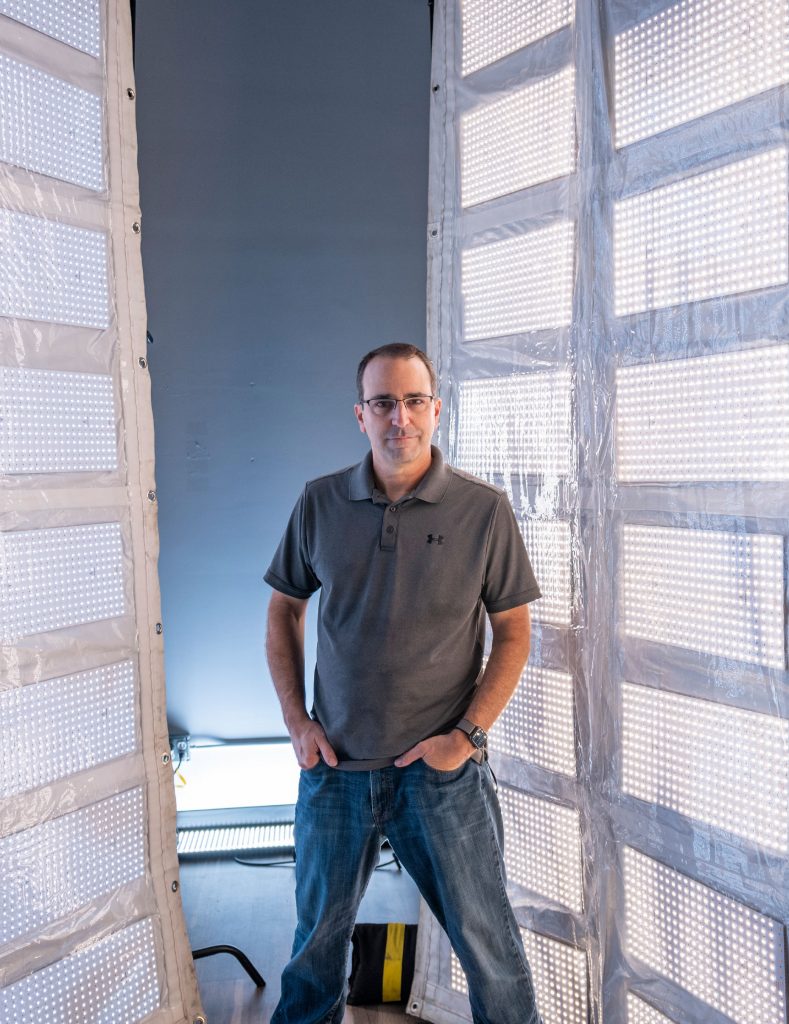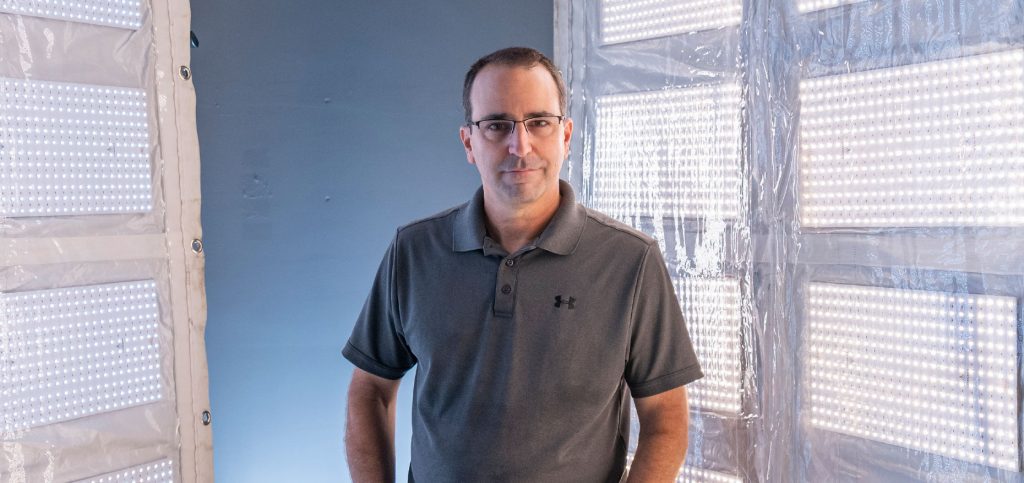Check out this ICG article featuring our Executive Chairman & Co-founder, Al DeMayo. The article is a part of a series of inspiring stories of the individuals who have pushed the creative and innovative boundaries of lighting and camera technology and continue to do so.
ICG’s Pauline Rogers and Al discuss his work with the Solid-State Lighting Subcommittee of the Motion Imaging Technical Council (MITC) at the ASC, LED technology, the future of lighting, and lighting for virtual production.
This article is featured in the ICG Magazine, July 2021 Interview Issue (“Bright & Shiny”)
Written by Pauline Rogers
Photos by Local 600 Still Photographer Tobin Yelland
Al DeMayo
A working member of IATSE Local 728, Al DeMayo began his career as a lighting technician on commercials, music videos and features. In the 1990s, DeMayo and his partner, Claudio Miranda, ASC, formed a small lighting company eventually sold to Mole Richardson. DeMayo stayed on, becoming director of product development. In 2006, DeMayo, Rigging Gaffer Jeff Soderberg, and Chief Lighting Technician Mike Bauman formed LiteGear Inc., an early pioneer of ultra-thin and flexible LED lighting products. In addition to serving as chairman of the board at LiteGear, DeMayo leads mobile app development for TechScout Systems, is an active chief lighting technician, and is an associate member of the ASC.
As vice-chair of the Solid-State Lighting Subcommittee of the Motion Imaging Technical Council (MITC) at the ASC, you are in the perfect position to look to the future. What is the committee looking at?
Color science. Our goal is to recommend best practices for measuring and quantifying light for cinema. The challenge is the use of four or more colored LED’s to achieve the desired result. When you are color-mixing three colors, such as RGB, the results are much simpler to predict through triangulation. Add a fourth, and now metamerism comes into play. Metamerism is a perceived matching of colors with different (nonmatching) color combinations. These differences are why different manufacturers’ white light output often varies even at the same CCT. So, how do we properly define cinematic white light along the Planckian curve and consider plus/minus green shades? We’re working on it.
What are the pluses of using LED’s today?
The story is about the use of microprocessor devices to control light. Today, an LED, which is simply a semiconductor that, when powered, emits a photon (light), is the easy part. LED’s are one-thing-well devices that emit a single-color, at a single level of brightness, full output. This leads to the single most important characteristic of LED’s – the ability to be switched on and off at blazingly fast speeds. The most common switching process alternates an LED between completely off and on, in a pattern that results in perceived dimming. Switching the LED on half of the time and off the other will result in the output appearing to be continuous at half the maximum brightness or 50 percent. Because the LED is never dimmed the way other technologies are, the output color appears unchanged at every level of brightness.
With the advantages being…?
Well, using precise control of each color combined with scientific methods of color mixing and good old filmmaking techniques allows for any color and any brightness light fixtures to be reliably used on film sets worldwide. Another major plus is the ability to easily make arrays of nearly any shape. What we call an LED is an LED package often containing just one LED chip. RGB LED’s are single packages with multiple chips in red, green and blue. White LED’s are blue chips with an applied phosphor that converts blue light to white. Luckily, the LED packages we use have a nice and smooth output field, often with a great tapered edge that is free from color shift.
What should filmmakers new to LED watch out for or learn about?
All multi-color light fixtures are not created equal. When white light is desired from a multi-color fixture, be sure that the color processing is done in the fixture, and don’t rely on the DMX console. White light for cinema camera capture is very particular, especially when cast upon actors with varying skin tones. Each manufacturer uses advanced processes to achieve the best possible white light color, and, in my experience, console-level color mixing doesn’t always meet expectations.
Any examples?
ARRI’s SkyPanel uses red, green, blue and white emitters. ARRI did the color science; the console provides the interface. Other RGBW fixtures that rely on off-board color-mixing techniques fall short of cinematic acceptability. Consumer-level LED controllers can also be a problem. They flash on and off in a pattern that appears continuous at the desired brightness. But the camera is not a continuous capture device, as it, too, strobes. This is where economical LED dimmers and controllers can cause problems on set.
So using consumer gear on set in a reliable fashion is a challenge?
Definitely. Taking into account the camera’s frame rate, shutter angle, and rolling shutter, as the pulsing LED must not conflict with the sensor of the camera. It’s best to do an iPhone camera test when selecting. Dim the LED ribbon or bulb down and use the camera app to capture the light hitting a nearby surface. Set your camera to its fastest frame rate, and try to adjust to the app’s exposure while looking for any rolling bars or strange patterns.
What have you learned in the field that will fuel the next generation of lighting development?
Anywhere pan-and-tilt adjustment. To adjust an older fixture back in the day, we had to get a ladder and apply a series of techniques to get it just right. Adjust the flood/spot, add a scrim, adjust doors, add a snoot, pan/tilt, or add gel filters. We’ve addressed some of these needs. But adding simple tilt-up or pan-left abilities would be quite welcome. Also, there are still no LED options for large HMI applications (9K, 12K, 18K). Considering all the benefits of LED over older technology, I think that an any-color and any-brightness “big gun” would be highly valued.
What are some of the unique ways LED’s are being used that change how we light?
Volumetric sets using LED walls everywhere are a game-changer for in-camera backgrounds. Virtual sets are easily created and manipulated. However, they fall short when that light falls onto real-life subjects such as actors, set elements, and props. This is where the opportunity to integrate cinematic lighting into the virtual production space exists. The main issue is that red, green, and blue light from the video wall is limited in the ability to accurately simulate the full-spectrum white light required by the camera. When the video wall is in frame and being captured directly by the camera, all appears acceptable. When light falls on a subject, such as their skin tones, the deficiencies in the color spectrum are revealed.
So is there a preferred way to light for virtual production?
Using modern cinematic light fixtures, with advanced color science to accurately simulate full-spectrum light and installing cinema lighting fixtures into virtual sets outside of the camera’s field-of-view, seems to be the preferred method for virtual production. Taking things one step further, companies like Disguise are offering the ability to insert these IRL (“in real life”) cinema light fixtures into 3D space and even send the RGB video signal along with it. At LiteGear, we interpret the simple RGB signal into a full-spectrum and cinematic white light that remains adjustable to the camera’s white-balance settings. The result looks like the actor is fully engulfed in the 3D environment while maintaining proper and accurate white points for the camera. It’s pretty cool to see.


To view the ICG Magazine July 2021 Issue, click here.

